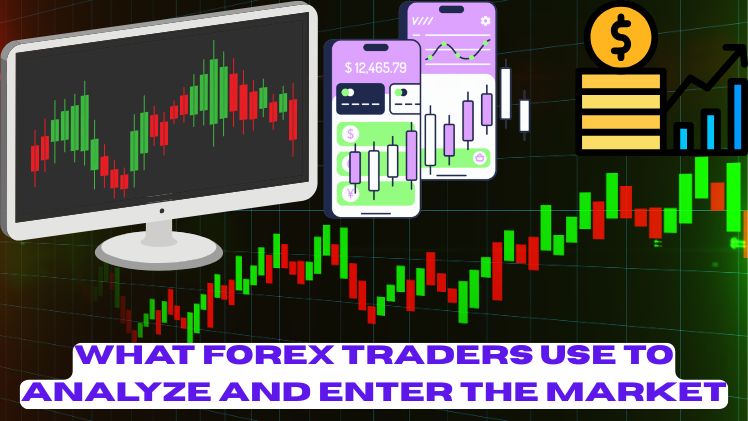What Forex Traders Use to Analyze and Enter the Market
The forex market is a vast and dynamic environment where currencies are traded around the clock. Every day, millions of traders participate in this market, analyzing price movements and making decisions to buy or sell currency pairs. Successful Forex Traders depends largely on how well a trader can analyze market conditions and identify profitable entry points. To achieve this, traders use a combination of analytical methods, tools, and strategies. This article explores what forex traders rely on to analyze the market and decide when to enter a trade.
Types of Market Analysis Used by Forex Traders
Forex traders primarily use two main types of market analysis—technical analysis and fundamental analysis. In addition, many traders incorporate sentiment analysis to gain a broader view of market conditions.
Technical Analysis
Technical analysis is the study of past price movements to predict future market behavior. This method is based on the idea that price patterns repeat over time and that all relevant market information is already reflected in the charts.
Traders using technical analysis look at historical price charts to identify trends, support and resistance levels, and key technical indicators. This approach is useful for both short-term and long-term strategies and is a foundation of day trading and swing trading.
Key tools in technical analysis include:
- Price Charts: The most commonly used chart types are line charts, bar charts, and candlestick charts. Candlestick charts are particularly popular because they provide more information about price movements in a given period.
- Trendlines: These are used to connect significant highs or lows on a chart, helping traders identify the direction of the market.
- Support and Resistance Levels: Support levels indicate where the price tends to stop falling and bounce back up, while resistance levels show where the price tends to stop rising and reverse.
- Chart Patterns: Common patterns include head and shoulders, double tops and bottoms, and triangles. These patterns can indicate continuation or reversal signals.
- Technical Indicators: Traders use indicators like Moving Averages, MACD (Moving Average Convergence Divergence), RSI (Relative Strength Index), and Bollinger Bands to confirm trends and signal possible entries or exits.
Fundamental Analysis
Fundamental analysis focuses on the economic, political, and financial factors that influence currency values. Unlike technical analysis, which concentrates on price behavior, fundamental analysis aims to understand the reasons behind market movements.
Forex traders analyze macroeconomic data to assess the strength of a country’s economy and its currency. Key economic indicators include:
- Interest Rates: Central bank decisions on interest rates are major drivers of currency value. Higher interest rates often attract foreign capital, boosting the currency.
- Inflation Rates: Inflation affects purchasing power and influences central bank policies. Stable inflation supports a strong currency.
- Employment Reports: Data such as the unemployment rate and job creation help gauge economic health and predict consumer spending.
- Gross Domestic Product (GDP): A growing GDP indicates a strong economy, often leading to a stronger currency.
- Trade Balances: A country with a trade surplus may see its currency appreciate due to higher demand for its goods and currency.
Traders monitor economic calendars to keep track of upcoming news releases. They prepare for high-impact events that can lead to significant volatility in the forex market.
Sentiment Analysis
Market sentiment refers to the overall mood or attitude of traders toward a particular currency pair. Sentiment analysis tries to determine whether traders are feeling optimistic (bullish) or pessimistic (bearish) about the market.
Some tools that help gauge sentiment include:
- Positioning Reports: These show how many traders are long or short on a currency pair.
- Volume Indicators: An increase in volume during a price move can indicate strong conviction behind the trend.
- News Sentiment: Headlines and financial commentary often shape trader expectations and influence price behavior.
While sentiment alone doesn’t provide clear entry signals, it helps traders understand the emotional tone of the market and whether to follow or go against the crowd.
Entry Strategies Based on Analysis
Once a trader has analyzed the market using one or more of the above methods, the next step is to determine when to enter a trade. Entry strategies vary depending on trading style and objectives.
Some common entry strategies include:
- Breakout Trading: Traders enter a position when the price breaks through a support or resistance level, signaling the start of a new trend.
- Pullback Trading: This strategy involves waiting for a temporary price retracement during a trend and entering when the trend resumes.
- Trend Following: Traders look for confirmation that a trend is strong and enter trades in the same direction, often using moving averages as signals.
- Range Trading: In a sideways market, traders buy near support and sell near resistance, using technical indicators to time their entries.
Each of these strategies requires a combination of technical tools and analysis to confirm trade setups.
Order Types for Entry
Traders use different types of orders to enter the market:
- Market Orders: Execute the trade immediately at the current market price.
- Limit Orders: Set a specific price at which to enter the market. The order is filled only if the price reaches that level.
- Stop Orders: Trigger a trade when the price moves beyond a certain level, often used in breakout strategies.
Proper use of order types allows traders to manage risk and execute their strategies with precision.
Risk Management During Market Entry
Risk management is crucial when entering the forex market. Even the best analysis can be wrong, so traders must protect their capital. Some common practices include:
- Stop-Loss Orders: These automatically close a losing trade at a predefined level to limit losses.
- Position Sizing: Traders calculate the appropriate trade size based on their account balance and risk tolerance.
- Risk-to-Reward Ratio: A ratio of at least 1:2 is often used, meaning the potential reward is twice the amount risked.
- Diversification: Traders may spread their exposure across different currency pairs to reduce the impact of one poor-performing trade.
Combining Analysis Methods
Many traders find success by combining different types of analysis. For example, a trader might use fundamental analysis to identify a currency likely to strengthen, then use technical analysis to find the best entry point. Sentiment analysis can then be used to assess whether the market agrees or if there’s an opportunity for a contrarian trade.
Combining methods allows traders to approach the market with greater confidence and clarity.
Conclusion
Analyzing and entering the forex market is a process that requires skill, patience, and the right tools. Traders rely on technical analysis for chart patterns and indicators, fundamental analysis for economic insights, and sentiment analysis for gauging the mood of the market. They use entry strategies based on these analyses and apply risk management techniques to protect their capital.
By mastering these methods, forex traders can make more informed decisions, reduce emotional mistakes, and improve their overall trading performance. Whether you’re a beginner or an experienced trader, understanding how to analyze the market and when to enter a trade is a vital part of long-term success in the forex market.







